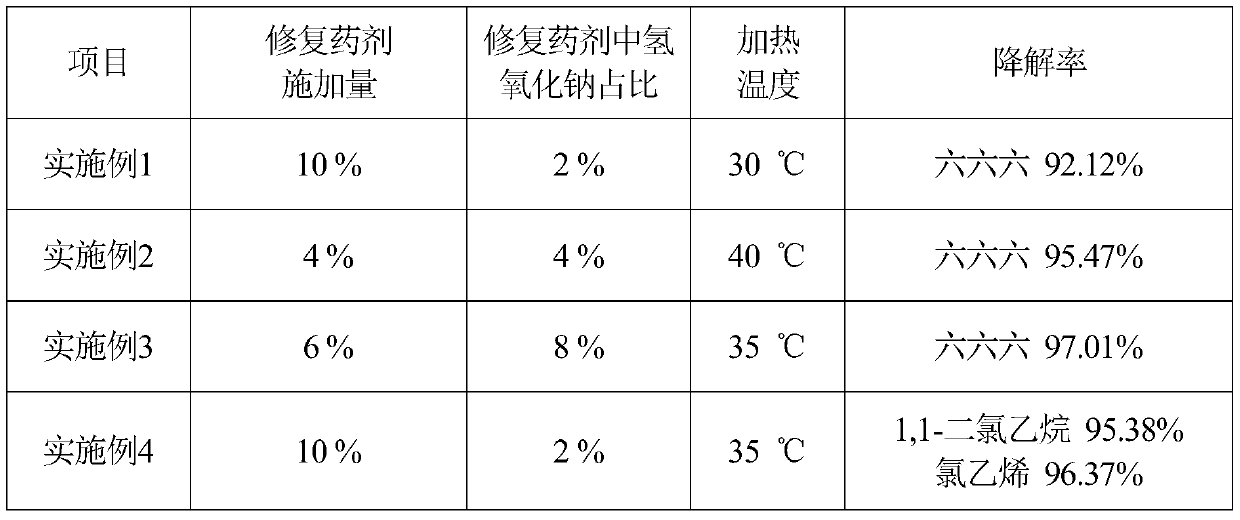Thermal strengthening assisted in-situ chemical oxidation method for remediating organic contaminated soil
An in-situ chemical oxidation and organic pollution technology, applied in the field of organic polluted soil treatment, can solve problems such as high repair cost and constraints, and achieve the effects of high repair efficiency, heat saving, and increased diffusion radius.
- Summary
- Abstract
- Description
- Claims
- Application Information
AI Technical Summary
Problems solved by technology
Method used
Image
Examples
Embodiment 1
[0023] This embodiment is used to repair the soil polluted by the organochlorine pesticide HCH, and the specific operations are as follows:
[0024] Step (1), remove sundries such as steel bars, gravels, wood, etc. on the surface of the polluted soil, and use a rotary tiller to mix the restoration agent with the contaminated soil with a thickness of 300mm on the surface and then flatten and compact it. The dosage of the restoration agent is polluted 10% of the soil mass, the restoration agent is an aqueous solution of sodium hydroxide and sodium persulfate composition, its mass concentration is 20%, and the dosage of the sodium hydroxide is 2% of the mass of sodium persulfate;
[0025] Step (2), use the GPS locator to arrange points according to the triangle method, and the parameters of the point arrangement ensure that the repair area is completely covered within the diffusion radius of the repair agent;
[0026] Step (3), using a high-pressure rotary jet injection device to...
Embodiment 2
[0032] This embodiment is used to repair the soil polluted by the organochlorine pesticide HCH, and the specific operations are as follows:
[0033] Step (1), remove sundries such as steel bars, gravels, wood, etc. on the surface of the polluted soil, and use a rotary tiller to mix the restoration agent with the contaminated soil with a thickness of 300mm on the surface and then flatten and compact it. The dosage of the restoration agent is polluted 4% of the soil quality, the restoration agent is an aqueous solution of sodium hydroxide and sodium persulfate composition, and its mass concentration is 20%, and the dosage of the sodium hydroxide is 4% of the quality of sodium persulfate;
[0034] Step (2), use the GPS locator to arrange points according to the triangle method, and the parameters of the point arrangement ensure that the repair area is completely covered within the diffusion radius of the repair agent;
[0035] Step (3), using a high-pressure rotary jet injection ...
Embodiment 3
[0041] This embodiment is used to repair the soil polluted by the organochlorine pesticide HCH, and the specific operations are as follows:
[0042] Step (1), remove sundries such as steel bars, gravels, wood, etc. on the surface of the polluted soil, and use a rotary tiller to mix the restoration agent with the contaminated soil with a thickness of 300mm on the surface and then flatten and compact it. The dosage of the restoration agent is polluted 6% of the soil quality, the restoration agent is an aqueous solution of sodium hydroxide and sodium persulfate composition, and its mass concentration is 20%, and the dosage of the sodium hydroxide is 8% of the quality of sodium persulfate;
[0043] Step (2), use the GPS locator to arrange points according to the triangle method, and the parameters of the point arrangement ensure that the repair area is completely covered within the diffusion radius of the repair agent;
[0044] Step (3), using a high-pressure rotary jet injection ...
PUM
 Login to View More
Login to View More Abstract
Description
Claims
Application Information
 Login to View More
Login to View More - R&D
- Intellectual Property
- Life Sciences
- Materials
- Tech Scout
- Unparalleled Data Quality
- Higher Quality Content
- 60% Fewer Hallucinations
Browse by: Latest US Patents, China's latest patents, Technical Efficacy Thesaurus, Application Domain, Technology Topic, Popular Technical Reports.
© 2025 PatSnap. All rights reserved.Legal|Privacy policy|Modern Slavery Act Transparency Statement|Sitemap|About US| Contact US: help@patsnap.com


